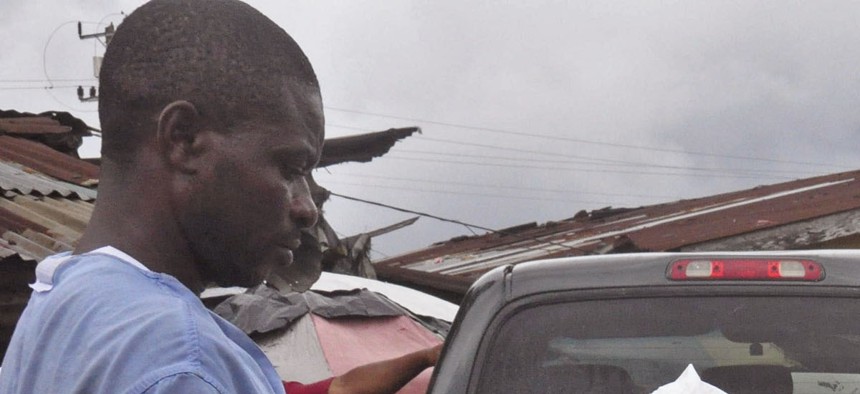
Health workers in Monrovia, Liberia, remove their protective clothes after carrying the body of a woman who may have died from the Ebola virus, on September 10, 2014. Abbas Dulleh/AP
Africa Needs the US Military To Fight Ebola
It’s up to the international community to change its response behavior and question its own assumptions about disease containment. By Melissa Hersh
Both civilian and military public health experts understand how to contain highly transmissible infectious diseases, such as SARS, avian influenza, the MERS Coronavirus, and other pandemic-prone diseases. These diseases are threats to global security that could lead to outbreaks with significant costs including massive loss of life, a weakened work force, geopolitical instability, and economic disruption and losses. But given the relative successes in responding to these diseases, it has been surprising and disappointing that collective international actions against Ebola have thus far proven largely unsuccessful.
As Laurie Garrett, senior fellow for global health at the Council on Foreign Relations, rightly points out, Ebola won’t be stopped with principles of global solidarity and earnest appeals. Disjointed and erratic funding efforts, dozens of volunteer health workers, and closing national barriers in West African states is either too little, too late, or too ineffective. Like Heracles slaying the many-headed Hydra, cutting off the beast’s individual heads was not enough; only by cauterizing the stumps was he able to contain the threat. Like Heracles, we must evaluate our futile tactics and engage an asymmetric advantage to bring to a halt this unprecedented yet containable Ebola outbreak.
Changing the dynamics of the West African outbreak requires behavioral changes including adjustments to burial practices and sanitation issues that are particularly conducive to the spread of Ebola. The consumption of bushmeat—that is, animal meat from the wild rather than domestically farmed—is also a significant risk factor. On a societal level, there are more broad-based cultural factors at play including a serious mistrust of health aid workers and the national government.
Seeing as deeply entrenched cultural practices cannot change overnight, it is up to the international community to change its response behavior and question its own assumptions about disease containment. Just as Medicins sans Frontieres has done, the global public health community must recognize that the approach to isolate the ill, trace and quarantine contacts, and maintain provider safety and wellness cannot be done with the current logistical operations, conflicting demands on resources, and a lack of a central coordinating body.
This is where the “security” in “global health security” comes into play. The introduction of a multi-national civil-military force on the ground in affected West African countries is critical. Deploying military capabilities in the form of mobile laboratories, surveillance and notification communications technology, logistics systems, and deployable health facilities are all part of the equation that will truly work against this outbreak.

With significant military resources on the ground, “force protection”—that is, armed personnel— becomes a likely requirement. Why would protecting military assets on the ground be necessary? Some things are as easy as physical security, preventing the theft of a generator. Other reasons relate to operating in an unstable environment and not allowing civilian criminal activity to impact the mission. At the other end of the spectrum is unconventional warfare arising in an impacted country due to government instability.
What does President Barack Obama’s proposed 3,000-person deployment look like? There are many possible sources within our current military structure. The U.S. already has Joint Task Force Civil Support (JTF-CS) tasked with responding to Chemical, Biological, Radiological, Nuclear, and High-Yield Explosive (CBRNE) events in the homeland. This standing, operational task force is trained to effectively liaise with civilian authorities at the local, state, and federal levels in the most extreme circumstances. Thus, it follows that JTF-CS can use these very same command and control capabilities to work with national governments in the response to a disease outbreak Outside of the Continental United States (OCONUS).
In addition to the command and control structure that JTF-CS provides, the U.S. maintains a scalable disaster response force. All of these forces can operate in chemically or biologically contaminated environments and render some degree of medical care and have some element of self-protection. The smallest of these units are the CBRN Enhanced Response Force Packages (CERF-P), National Guard entities with 170 personnel. The next largest is the Homeland Response Force (HRF) another National Guard team that provides 570 personnel. There are 17 CERF-Ps and 2 HRFs spread amongst the states. The largest possible response element is the Defense CBRNE Response Force (DCRF): 15,000 active duty military personnel with medical (including personnel protection and decontamination), engineering, logistics (including mass fatality management), and aviation capabilities.
The use of metaphors linking war, terrorism, and health has a long history; some question the merits of calling a terrorist cell a ‘cancer’ or alleging that disease is a threat to security. But why should we not work to rally the very same political, financial, and military support for containable, pandemic-prone diseases that we do for any other destabilizing force? Health security is both a national and international risk if left unchecked.
Is the use of a traditional military force, albeit for the purposes of providing capabilities the civilian response, in a public health response a slippery slope? There is the risk that the presence of foreign military personnel will contribute to fears over abuse of power or as a pretext for racial, ethnic, and religious incarceration or extermination. This risk must be discussed further. For many, attempting to restrict how and what local communities do when it comes to slaughtering animals for consumption and how they bury their dead are seen to be out of bounds for others to judge.
When resources are lacking and impacted nations are willing, the international public health community can intervene with a positive result. A movement towards a combined military and civilian response in the Ebola crisis should be the catalyst for a broader, open discussion about the employment of military forces to support civil authorities in mitigating a public health crisis, particularly when people on the ground are unwilling to respond and local governments are unable to take action.
Melissa Hersh is a Washington D.C.-based risk analyst and a fellow at the Truman National Security Project. Views expressed are her own.




